Text

Our book, "Russian Icons from the Mid-17th to the Early 20th Centuries: The Collection of Oleg Kushnirskiy (Русская икона середины XVII - начала XX века. Коллекция Олега Кушнирского)," is gradually appearing on the market.
You can already buy it in such stores as labirint.ru, book24.ru, chitai-gorod.ru, and bgshop.ru, among others.
Please note that it is a limited edition! 😉
#artbook#bookstagram#artnews#newbook#iconography#russianicon#russianicons#christianart#christianbook#orthodoxicons#orthodoxart#religiousart
17 notes
·
View notes
Text

We are happy to announce the highly anticipated release of the book "Russian Icons from the Mid-17th to the Early 20th Centuries: The Collection of Oleg Kushnirskiy" published by "EKSMO"! Edited by art historian Sofia Birina, this is the first extended catalog of Oleg Kushnirskiy's icon collection, introducing it to the academic discourse.
We are very grateful to our authors — Anna Ivannikova, Dr. Wendy Salmond, and Dr. Alek D. Epstein, as well as to experts — Sergey Khodorkovskiy and Nikolay Zadorozhny, the director of the Museum of Russian icon, for their contribution to our book project and our mission of researching and promoting the Russian icon painting all over the world.
We also thank Sergey Brun for the translation, Andrey Chumachenko for the design, and Pavel Ascheulov for the photos!
#russianicon#russianicons#artbook#iconography#artcollection#antiques#publication#artnews#orthodoxicons#orthodoxart#christianart#religiousart
261 notes
·
View notes
Text

The Russian icon you can see in the picture bears the image of the Resurrection – the Harrowing of Hades, an extremely popular iconographic scene in the 19th-century Russian Empire. The centerpiece is surrounded by two tiers consisting of 28 border scenes, which adds complexity to the overall composition of the icon. Apart from the sixteen border scenes depicting the Orthodox Feasts, there is also an inner cycle displaying the last days of Christ, also known as the Passion. In addition to the Harrowing of Hades, the centerpiece features images of the angels marching toward the Gates of Hell, and the Pious led by the Good Thief to Heaven. The outer corners of the icon are reserved for the depictions of the Four Evangelists.
#iconography#russianicon#resurrection#jesuschrist#religiousart#orthodoxy#orthodoxart#christianart#orthodoxicons#russianiconography
17 notes
·
View notes
Text
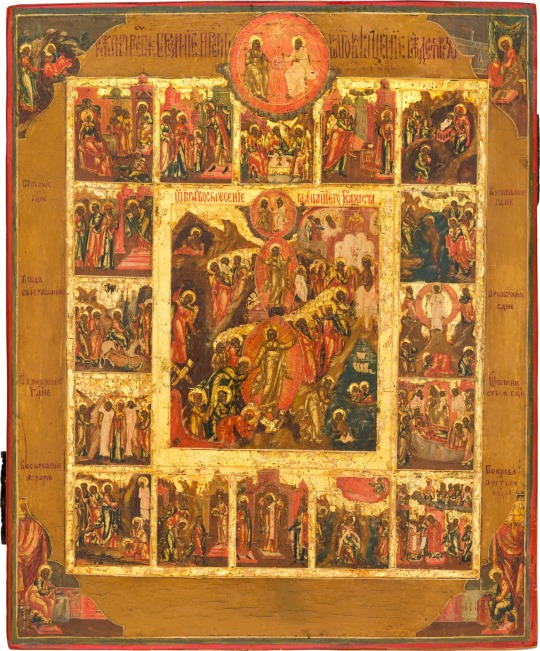
The featured icon of the Resurrection – the Harrowing of Hades is part of a long tradition that was especially strong in Palekh. The centerpiece of this beautiful icon depicts the scene of the Resurrection and is surrounded by highly detailed border scenes. We can also see the figures of the Four Evangelists in each corner of the image. Since icons like this one featured the Major and Minor Church Feasts, they were often used by Orthodox believers as an agricultural calendar. Other distinguishing features of this antique piece are its darker color pallet, draft-like manner of painting, and dry gold hatching on the vestments, which points to the fact that the icon was created in the 19th century.
#resurrection#iconography#russianicon#religiousart#orthodoxart#orthodoxicon#christianart#russianicons#religiousicons#orthodoxy
13 notes
·
View notes
Text

This extremely detailed 19th-century icon depicting various religious scenes is a miniature representation of the traditional icon screen, also known as the iconostasis, which is used to separate the nave from the sanctuary in Russian Orthodox churches. The icon features six registers separated into smaller images of the prophets, saints, and church feasts. The scenes of the Synaxis of the Archangels, the Pokrov of the Mother of God, the Trinity, the Beheading of St John the Forerunner, the Dormition, and the image of St. Nicholas are placed between the Deacon's Doors. The main Orthodox church feasts can be seen in the second register. As for the compositional center of this antique piece, it is reserved for the image of Christ Enthroned. The icon is currently part of a private collection located in Germany.
#iconostasis#antiques#orthodoxart#christianart#religiousart#orthodoxicon#russianicon#russianiconography#iconography
688 notes
·
View notes
Text
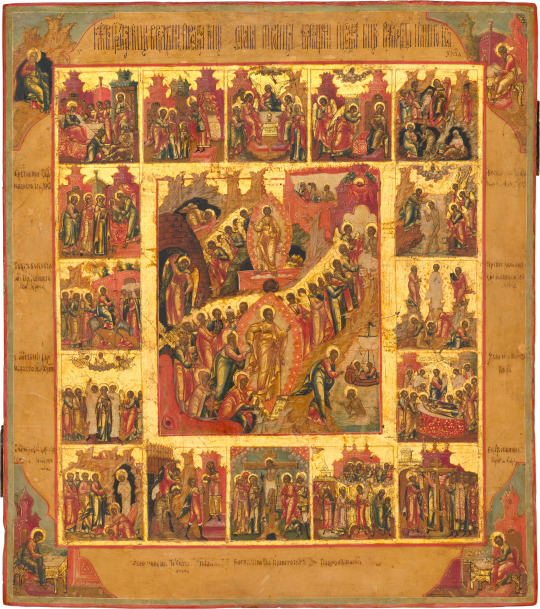
Palekh was the center of religious art in 19th-century Russia. It is where a unique iconographic tradition was developed. Icons that depicted the scene of the Resurrection — the Harrowing of Hades were especially popular with Orthodox believers of all social backgrounds at the time. Pieces created in Palekh were distinguished by the highly detailed and complex centerpiece surrounded by the border scenes with the Feasts of the liturgical year and the figures of the Four Evangelists in the corners. This particular icon also has an interesting and unusual addition to the bottom tier – the Crucifixion scene, which points to the fact that it was painted for a private commissioner. Come learn more about this icon and the Palekh icon painting tradition on our website.
#russianicon#orthodoxart#christianart#antiques#iconography#resurrection#russianicons#resurrectionofchrist#antiqueart#iconpainting
41 notes
·
View notes
Text

The featured icon, which is titled "Crucifixion of Jesus," comes from the Festive cycle of the iconostasis that was once part of the Trinity Cathedral of the Pavlo-Obnorsky Monastery. It was painted in the 16th century by the renowned icon painter Dionysius. "Crucifixion of Jesus" represents a traditional scene of the Crucifixion. The Golgotha Cross and the Savior are placed in the center of the icon. The Mother of God and the myrrh-bearing women are depicted on one side of the cross; John the Theologian and the Roman centurion are on the other. The icon serves as a reminder of Christ’s sufferings and a promise of eternal life. It is currently stored in the State Tretyakov Gallery.
44 notes
·
View notes
Text

On March 2, the Museum of Russian Icons in Clinton, MA, opened an exhibition titled “Icons & Retablos: Images of Devotion.” Created in collaboration with the University Art Museum at New Mexico State University (NMSU), it features an amazing selection of Orthodox and Mexican religious art. What might seem like a surprising combination is actually an incredibly thoughtful and informative project that highlights the stylistic and ideological similarities between Orthodox icons and Mexican retablos. “Icons & Retablos: Images of Devotion” is on view at the Museum of Russian Icons through August 27, 2023.
Featured image: Our Lord of Sacromonte and Our Lady of Sorrows, Señor del Sacromonte y Nuestra Señora de los Dolores, Mexico, 19th century, Oil on tin, NMSU Permanent Art Collection, Donated by Gloria Giffords and the Giffords Family.
#orthodoxicons#russianicons#retablo#retablos#religiousart#catholicart#orthodoxart#christianart#newexhibition#museumofrussianicons#mexicanretablo
26 notes
·
View notes
Text

This amazing antique icon depicts the Prophet Solomon who was the king of ancient Israel. Solomon was the son of King David and one of the most prominent figures in the Old Testament. He is said to have lived in the 10th century BC and was known to be an exceptionally wise monarch. The featured icon is part of the iconostasis of the Church of Transfiguration in Kizhi Pogost, which is located in the Republic of Karelia. It was painted approximately in the first quarter of the 18th century. Religious images commonly depict Solomon as a young man dressed in royal vestments, with a crown on his head. In this particular icon, Solomon is also pointing toward a church.
#king solomon#russianicons#iconography#russianicon#orthodoxart#christianart#religiousicons#orthodoxicon#prophet
32 notes
·
View notes
Text
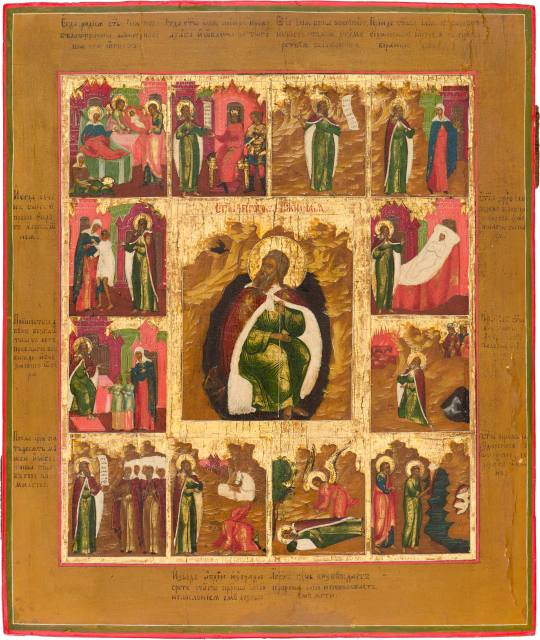
The featured icon depicts one of the most revered saints in Orthodox Christianity — the Prophet Elias. This piece is dated back to the 19th century and was probably painted in Guslitsy. The icon pictures the life of the Prophet, with its centerpiece dedicated to the scene titled “Prophet Elias in the Desert.” The most interesting thing about this specific piece is that it features a rather rare scene depicting Avdius, a servant of King Ahab, who saved Elias from death.
28 notes
·
View notes
Text
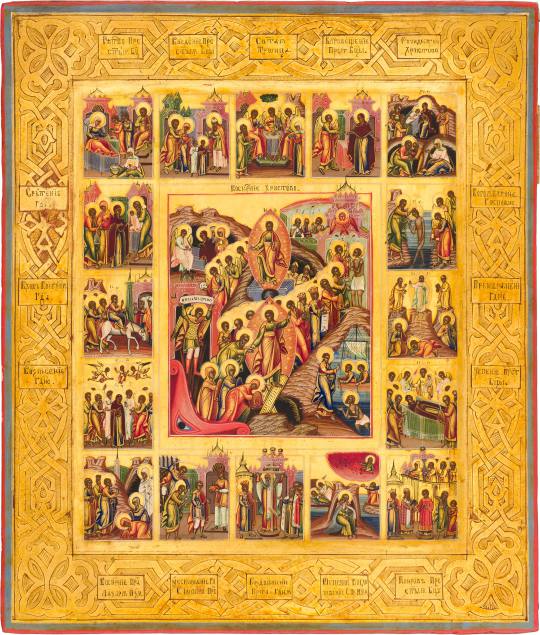
This amazing antique icon is an impressive piece of 19th-century Russian religious art. It features all the Great Feasts and Minor Feasts of the Orthodox liturgical year, as well as the scene of the Resurrection — the Harrowing of Hades in its centerpiece. The Feast cycle traditionally starts with the Nativity of the Mother of God and ends with the Pokrov. Such complex icons, which are called “polnitsy,” were popular among all social classes and were often commissioned by churches.
#orthodoxicons#orthodoxart#religiousart#resurrection#antiqueicons#russianicon#christianicon#christianart
24 notes
·
View notes
Text

The given icon depicts Saints Cosmas and Damian of Asia, who lived in the 4th century. They were born to a Greek couple and were taught medicine by their Christian mother. Cosmas and Damian of Asia went down in religious history as doctors who never took payment for their services and told their patients about the Christian faith. The distinct artistic style of the icon indicates that it was painted in the late 19th century by the master from Guslitsy, the center of Old Believer's religious life.
12 notes
·
View notes
Text

The featured icon is dedicated to the theme of the Resurrection — the Harrowing of Hades, which was especially widespread in Russia in the 19th century. The Resurrection of Christ is taking up the centerpiece, while the rest of the icon is separated into several rows of border scenes that include the Passion cycle and the Feast cycle, as well as the Monogenis and the images of the Four Evangelists. This beautiful icon was painted in the third quarter of the 19th century, most likely in Palekh, the most prominent icon painting school of the Russian Empire.
13 notes
·
View notes
Text

When it comes to the history of Russian icons, the most known iconographic school is Palekh. Visit our blog to learn more about Palekh icon painting and the amazing icon “The Resurrection – The Harrowing of Hades,” which was painted by an anonymous Palekh master in the last quarter – end of the 18th century. In addition to the main composition, it features the Holy Trinity and the Church Feasts in 16 border scenes.
19 notes
·
View notes
Text

On December 24, the Museum of the Russian Icon in Moscow opened an exhibition featuring a single masterpiece – the 16th-century icon of St. Nicholas of Myra (Velikoretsky) with a hagiographic cycle. The unique icon comes from a private collection of the art expert and collector Sergey Khodorkovskiy, and it is for the first time it is displayed to the public. The exhibition will be on view at the Museum through March 21, 2023. Visit our blog for details.
37 notes
·
View notes
Text
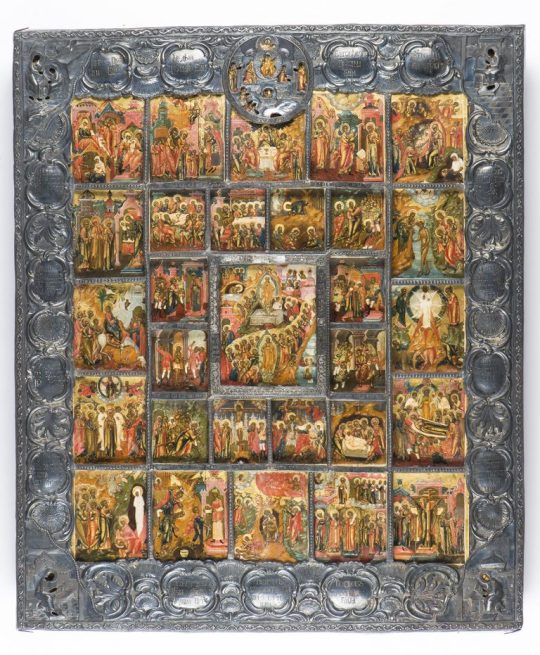
The featured hand-painted Russian Orthodox icon of the Resurrection is one of the precious gems of our collection. It consists of two multi-scene cycles containing the images of the Church Feasts, Passions of Christ, the Evangelist, and the Monogenes, among others. The piece is enclosed in a silver oklad cover, which stresses the subtle craftsmanship and visual symbolism of religious artwork. It is also worth noting that the master’s paintwork is in a pristine condition, with only some fragments of restoration visible. Check out our blog to learn more about this unique icon.
28 notes
·
View notes
Text

The hand-painted icon of the Iconostasis is a treasured piece of antique religious art, replicating the real iconostasis of the Moscow Kremlin’s Dormition Cathedral. Unlike early forms of this icon type, which consisted of only 3-4 tiers and were much lower, the given piece is comparably tall and includes six tiers. Each row features different historical events, prophecies, saints, Great Feasts, symbolic objects, and more. Russian Icon Collection is excited to own such an exceptional icon in our collection. Get to know more about it in our latest blog post.
#iconostasis#iconography#19thcentury#orthodoxicons#orthodoxicon#orthodoxart#iconpainting#russianiconcollection#privatecollection#saints#russianicons
20 notes
·
View notes